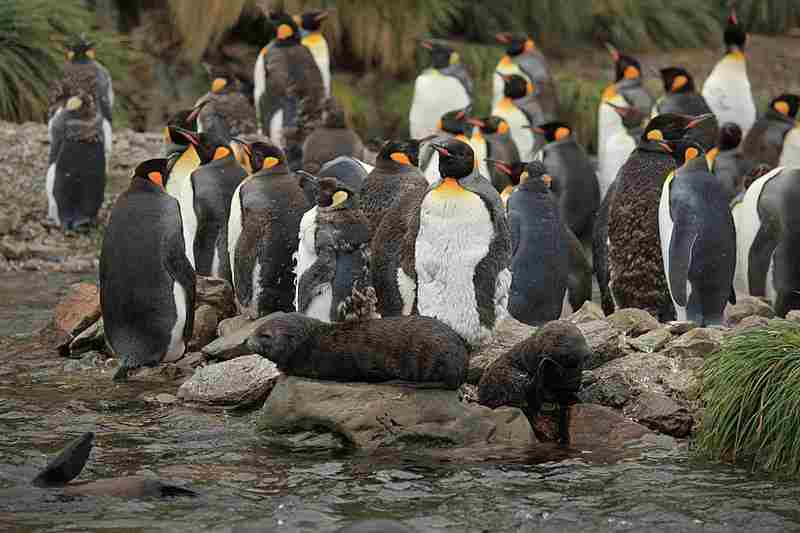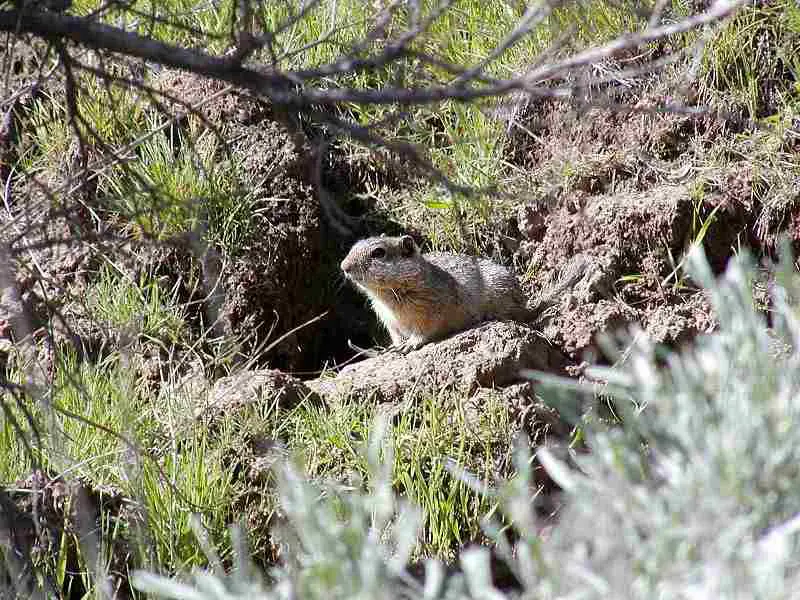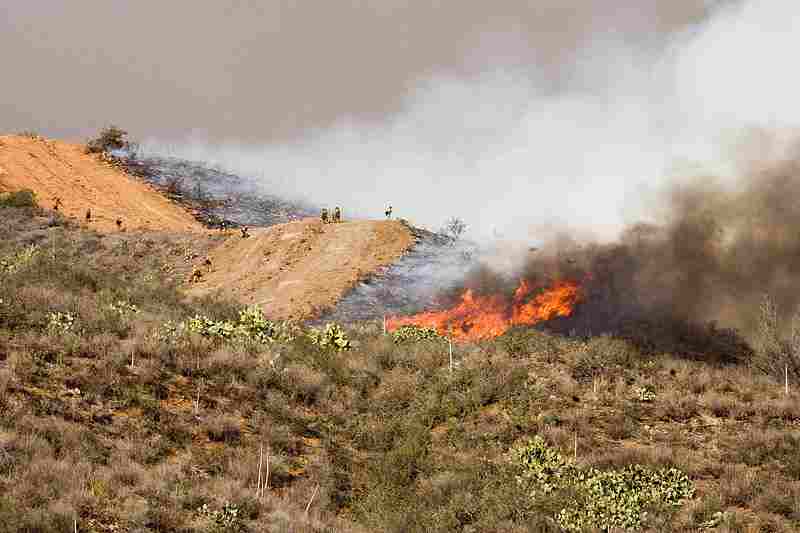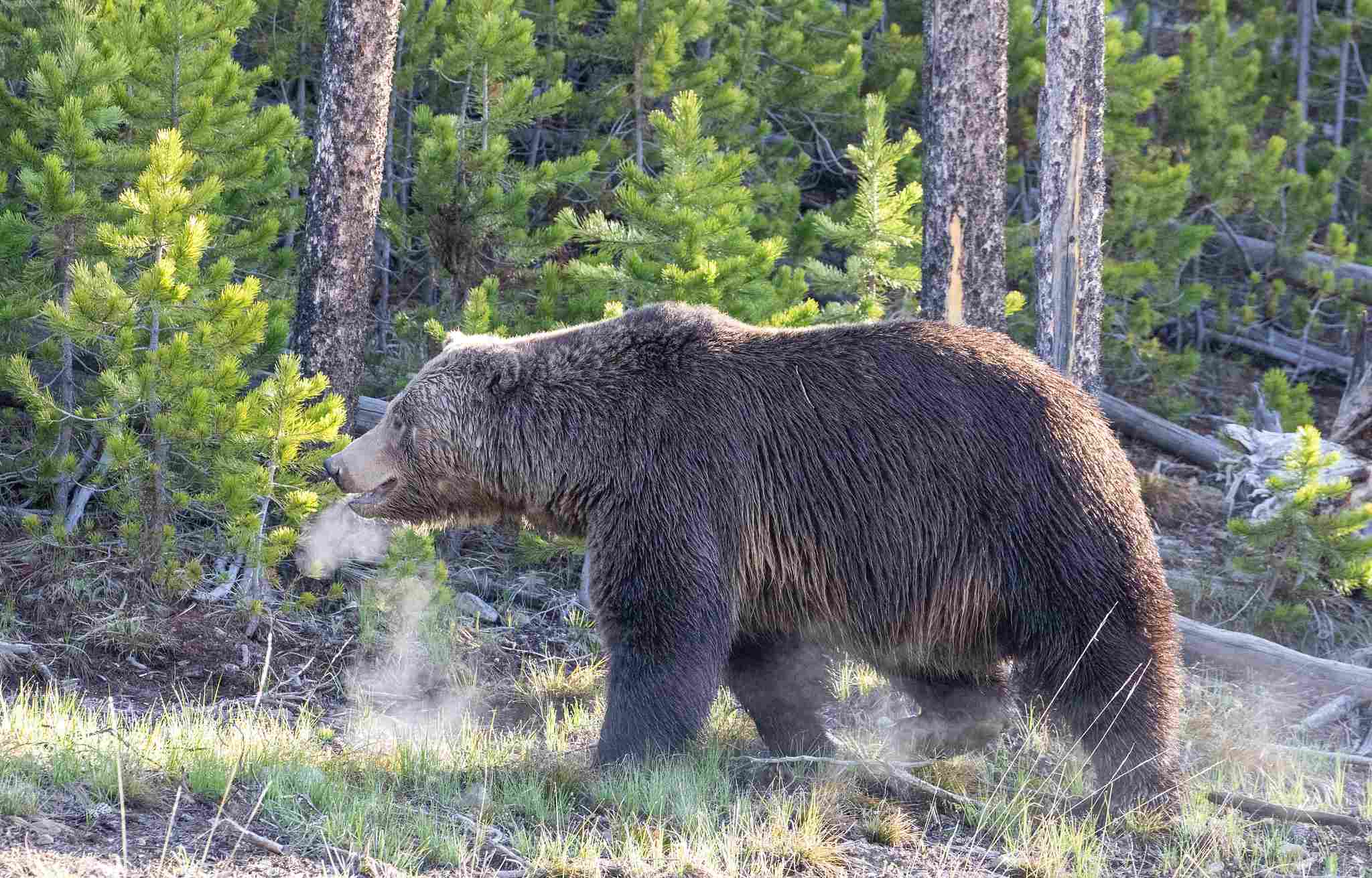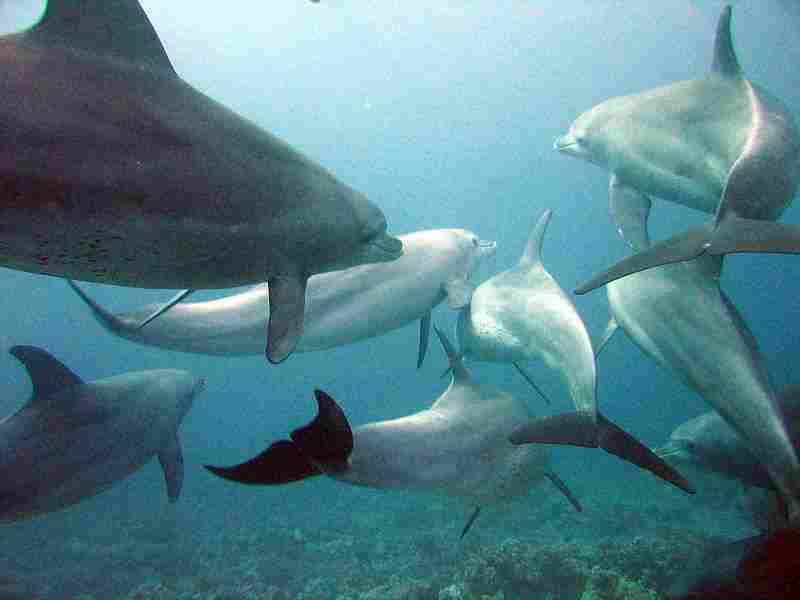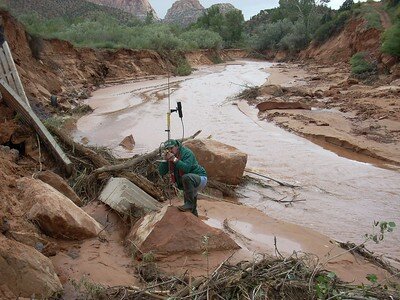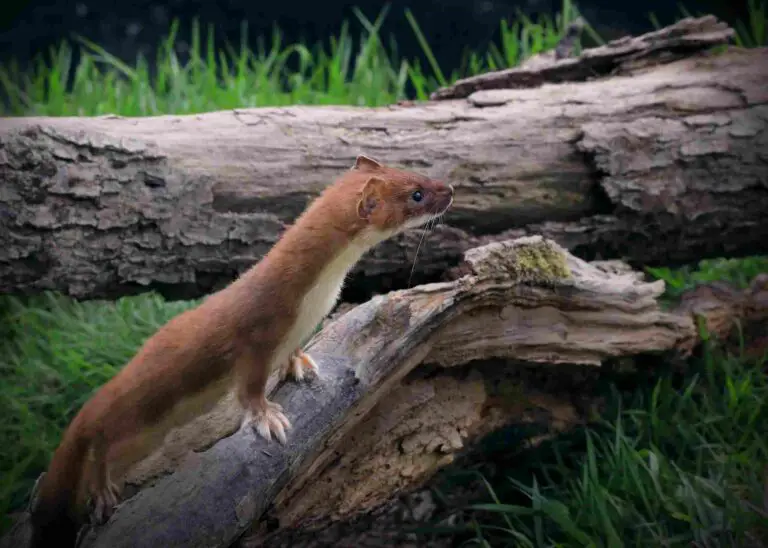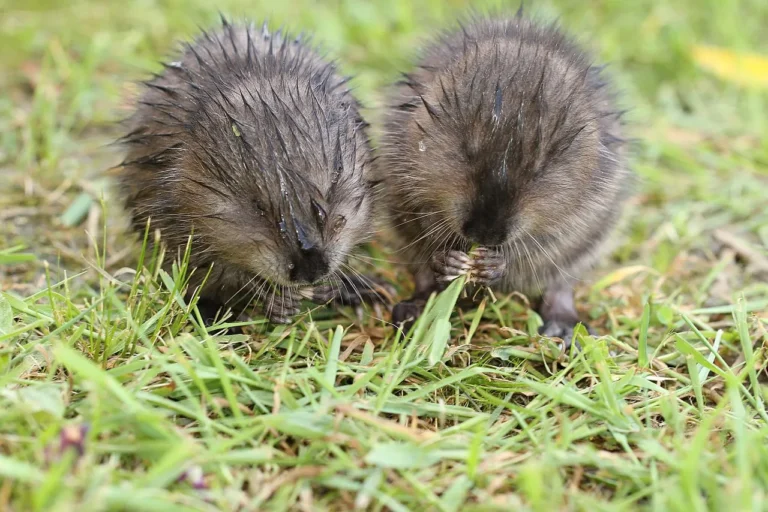11 Antarctica Biotic Factors and Their Characteristics
Antarctica biotic factors include; autotrophs, herbivores, carnivores, omnivores, decomposers, mutualism, parasitism, commensalism, predation, competition, and adaptation.
This article discusses chaparral biotic factors and their characteristics, as follows;
1). Autotrophs (as one of the Antarctica Biotic Factors)
Autotrophs are a vital component of Antarctica's ecosystem, functioning as primary producers that sustain organic life in this harsh and remote environment.
Despite the extreme cold and challenging conditions, certain plants, lichens, and algae have adapted to thrive as autotrophs, contributing to the diversity and structure of the Antarctic region [11].
Importance of Autotrophs in Antarctica
Autotrophs are important in Antarctica due to their role as founders of the Antarctic food chain, and their contributions to energy transfer, nutrient cycling, habitat creation, oxygen production, carbon sequestration, and erosion control.
The base of the food chain in Antarctica is comprised of autotrophs, which produce organic compounds (biomass) through photosynthesis. These organisms convert solar radiation, carbon dioxide, and multiple inorganic nutrients into bioenergy-rich molecules that serve as food for other organisms [3].
By capture solar energy during photosynthesis, autotrophs play a role in Antarctic energy transfer. Solar energy serves the primary source of energy for the entire ecosystem, and drives the biological processes of all organisms either directly or indirectly.
Nutrient cycling is yet another role of autotrophs, which are involved in the continuous consumption and recycling of nutrients in the ecosystem. As they take up inorganic nutrients from the environment, they assimilate and incorporate these nutrients into their tissues. When they are consumed by other organisms, or die and undergo biodegradation, these nutrients are released back into the environment.
Autotrophs including symbionts, vascular and non-vascular plants like lichens mosses, and flowering plants, create microhabitats that offer protection and milder conditions (including increased temperature and humidity) for other organisms. They contribute to the formation of soil and provide essential resources for other species.

Oxygen production is another outcome of photosynthesis in Antarctica.
Autotrophs release oxygen as a photosynthetic byproduct, into the atmosphere, which is vital for the respiration of other organisms, including macroscopic animals and microbes. This implies that the oxygen cycle is supported significantly by autotrophs.
With regards to carbon sequestration, autotrophs are effective for removing carbon dioxide from the atmosphere and storing it in their tissues. This supports/sustains the carbon cycle, and helps regulate atmospheric carbon dioxide levels.
In areas where autotrophs establish colonies, their root systems usually increase the stability of soil and prevent erosion. This is particularly important in the fragile and windy Antarctic environment that is prone to snow-induced mass movement hazards.
Examples of Autotrophs in Antarctica
Examples of autotrophs in Antarctica are; mosses, lichens, algae, cyanobacteria, and angiosperms like Antarctic hair grass (Deschampsia antarctica) [1].
Certain species of mosses, such as Polytrichum and Bryum, can be found in sheltered areas with sufficient humidity. These autotrophs form small, low-lying organic cushions that can capture and retain moisture in the cold environment.
Lichens can be described as a symbiotic partnership between fungi and photosynthetic algae or cyanobacteria [4]. They can tolerate extreme cold and are often found on rock surfaces, where they provide a habitat for other organisms.

Algae, including diatoms, can be found in aquatic habitats such as meltwater streams, lakes and ponds. They contribute to the base of the aquatic food chain in Antarctica.
Cyanobacteria, also known as blue-green algae, are photosynthetic bacteria that can colonize ice surfaces and even thrive underneath layers of snow.
2). Antarctic Herbivores
In the harsh, frigid environment of Antarctica, herbivores are pivotal role to the maintenance of ecological balance and sustenance of life.
By definition, herbivores are organisms that primarily feed on plants, algae, and other autotrophic organisms. In spite of the challenging conditions, some species of herbivores have adapted (physiologically, behaviorally) to survive and thrive in Antarctic environments.
Importance of Herbivores in the Antarctic
Herbivores in the Antarctic are important for their contributions to energy dynamics, regulation of plant populations, nutrient cycling, habitat modification, food supply for carnivores, and cascading effects.
The second trophic level in the food chain is typically occupied by herbivores, which directly consume autotrophic organisms. By doing so, these animals efficiently transfer the energy captured by autotrophs (during photosynthesis) to higher trophic levels, occupied by carnivores and omnivores.
Regulation of plant populations is another function of herbivores, which exert trophic control over the plants they consume [12].
Grazing pressure from herbivores prevents the overgrowth of autotrophic organisms and overpopulation of their communities, which could otherwise foster unfavorable competition for limited resources. This maintains a healthy balance within the ecosystem, and prevents resource depletion.
As herbivores consume autotrophs, they break down and assimilate organic matter, releasing nutrients through digestion and excretion. These nutrients contribute to soil fertility, and support the overall scheme of Antarctic nutrient cycling, benefiting both local autotrophs and heterotrophic organisms.
Habitats in Antarctica are shaped and modified continuously by herbivores. These organisms can shape the landscape by influencing the distribution and species-composition of plant communities.
This affects the spatial and volumetric density of vegetative covering, which in turn determines the effectiveness of agents of erosion like wind and glaciers.
The consumption of plants by herbivores can influence the pattern of regeneration on Antarctic lands, thereby determining the availability of microhabitats for other organisms, and possibly leading to changes in species richness/biodiversity.
Also, herbivores are a crucial source of food for carnivores and omnivores in the Antarctic ecosystem. Predators that feed on herbivores help to maintain the population dynamics of both herbivores and autotrophs.
Some herbivores can be considered keystone species, meaning their presence (or absence) has a disproportionately large impact on the structure and functionality of the ecosystem [10]. Changes in the abundance and distribution of these species can trigger cascading effects throughout the Antarctic food web.
Examples of Herbivores in Antarctica
Examples of herbivores in Antarctica include terrestrial species like guanaco, and aquatic organisms like some mollusks. Some non-native herbivores like rabbits and sheep can also be found in Antarctic and sub-Antarctic zones, where they often decimate native plant populations through overgrazing.
Omnivorous animals like krill (Euphausia superba) are sometimes classified as herbivores in Antarctic waters because of their heavy consumption of phyoplankton [14].

3). Carnivores (as one of the Antarctica Biotic Factors)
In Antarctica, carnivores represent a major biotic component of the ecosystem, despite their relatively low species-diversity and numerical abundance.
Carnivores (often referred to as predators), are heterotrophic organisms that primarily feed on organic matter in the tissues of other heterotrophs. In this extreme and challenging environment, these predatory animals play a key role in maintaining ecological balance and sustaining the delicate web of organic life.
Importance of Carnivores in Antarctica
The importance of carnivores in Antarctica is based on their involvement in population control, top-down regulation, disease control, energy flow, habitat indexing, and animal adaptation.
Antarctic carnivores help regulate the populations of species that serve as their prey. For example, by consuming herbivores, they prevent overpopulation of these species, which in turn prevents excessive grazing and habitat degradation.
As implied above, carnivores exert top-down control over the food chain. They control the abundance, adaptation and distribution of organisms in lower trophic levels, indirectly influencing the entire ecosystem.
Disease control can also be attributed to carnivores, which can limit the spread of diseases by culling weakened or sick individuals from prey populations. This function contributes to the health and sustainability of the ecosystem as a whole.
Energy flow trends are significantly impacted by carnivores, which occupy the highest trophic levels in the food chain, and acquire energy by consuming other organisms. They facilitate the transfer of energy from lower trophic levels to higher ones.
Like herbivores, some Antarctic carnivores act as keystone species, and have a disproportionately large effect on the ecosystem. The presence or absence of these organisms can lead to ripple effects throughout the food web/chain/energy pyramid.
The fear and avoidance of predation can influence the behavior of prey species, leading to adaptive changes in feeding habits, habitat selection, movement patterns; and even a decrease in reproduction rates [7]. This, in turn, affects the abundance and distribution of plant species.
Examples of Carnivores in Antarctica
Examples of carnivores in Antarctica include aquatic and semi-aquatic organisms like; seals, orcas, skua birds, penguins, and sea stars.
Antarctic seals, including species like the leopard seals (Hydrurga leptonyx),Weddell seals (Leptonychotes weddellii), and crabeater seals (Lobodon carcinophaga), often function as apex predators in the region. Their food primarily comprises of marine organisms like krill and fish; with other organisms like cepaholpods and birds also being potential prey.
Orcas (also called killer whales) are arguably the largest predators in the entire Antarctic ecosystem [8]. They are known to consume various marine mammals, including seals and even other whales.
Skua birds, including the South Polar skua (Stercorarius maccormicki), are opportunistic predators and scavengers. They feed on carrion, penguin chicks, and eggs.
Certain species of penguins, like the Adélie penguin (Pygoscelis adeliae), inhabit Antarctic environments. They are primarily carnivorous, feeding on krill, fish, and mollusks, among other organisms.
Some species of sea stars like Odontaster validus, feed on marine mollusks, worms, small fish and sea cucumbers in Antarctic waters.
4). Omnivores
Omnivores, the versatile feeders of the natural world, also hold a unique position in Antarctica's ecosystem.
These organisms play a role as biotic factors; in maintaining the delicate balance between various trophic levels, and contributing to the overall stability and health of the biome.
Importance of Omnivores in Antarctica
Omnivores in Antarctica are important for their contributions to ecological flexibility, resilience, nutrient cycling, population control, and diversity maintenance.
Ecological flexibility is supported by omnivores, through their remarkable ability to adapt their diets, on the basis of the availability of food. This adaptability is very helpful for sustaining life in an environment as challenging and unpredictable as Antarctica.
Contributions of omnivores to nutrient cycling can be observed in their consumption of both plant matter and animal biomass. They help to transfer nutrients from one trophic level to another, and ensure that essential elements are continuously circulated throughout the ecosystem.
Population regulation by omnivores follows a similar mechanism as carnivores, whereby the omnivores influence populations of vulnerable herbivores and other prey species.
They are perhaps more effective as population regulators because they can also directly consume autotrophs. By feeding on a variety of organisms, omnivores can help control the abundance of multiple populations.
Also, because omnivores often exploit various food resources, they mitigate the overconsumption of any single resource. This versatility of diet helps to maintain biodiversity within the ecosystem.
Examples of Omnivores in Antarctica
Examples of omnivores in Antarctica include; krill, and some seabirds.
Krill (Euphausiids) are small crustaceans that occur in the Southern Ocean, within the Antarctic marine zone.
An example of a krill within this region is Antarctic krill (Euphausia superba) which occupies the lower levels of the Southern Ocean food web. It feeds on phytoplankton, detrital organic matter and other materials, and serves as a vital food source for a broad range of marine animals, including whales, seals, and penguins.

Various species of seabirds in Antarctica exhibit omnivorous feeding behaviors. These include some petrels, skuas and kelp gulls.
5). Decomposers (as one of the Antarctica Biotic Factors)
Decomposers, while often overlooked, are essential biotic components of ecosystems.
They hold a key role in Antarctica's delicate ecological balance, through the recycling of nutrients, breakdown of organic matter, and maintenance of overall ecosystem health.
Importance of Decomposers in Antarctica
The importance of decomposers in Antarctica is based on their involvement in nutrient recycling, energy flow and waste management, among other functions.
In the area of nutrient recycling, decomposers like bacteria, fungi, and certain detritivorous invertebrates, break down plant and animal remains and waste, into simpler substances. This process releases essential nutrients back into the environment, and makes them available for use by other organisms.
Energy flow in the ecosystem is also supported by decomposers, through the breakdown of complex organic compounds into simpler products. The energy released from decomposed materials, is then transferred to other trophic levels through mineralization in soil, and direct consumption of decomposers/detritivores by higher-level consumers.
Waste management is yet another role that can be attributed to decomposers in the Antarctic. They help remove dead organisms and organic waste from the ecosystem, and prevent the accumulation of organic matter that could potentially lead to pollution or the spread of pathogenic diseases.
Examples of Decomposers in Antarctica
Decomposers in the Antarctic region include; bacteria, fungi, and nematodes.
Bacteria are among the most efficient and dominant decomposers in Antarctica. They break down organic remains and waste, into simpler inorganic compounds, which are then released into the environment, and serve as usable nutrients for other organisms.
Fungi represent another important group of decomposers that can be found in Antarctica. Like bacteria, they break down complex organic molecules and recycle used nutrients, contributing to soil conservation/fertility and nutrient availability.
Nematodes like Scottnema lindsayae, are active decomposers in Antarctic soils [6]. They feeding on detritus, thereby playing a role in the breakdown of organic matter, and facilitating nutrient cycling.
Importance of Decomposers in Antarctica
The importance of decomposers in Antarctica can be traced to nutrient cycling, ecosystem balance, and soil formation among other functions.
In an environment with limited nutrient availability, Antarctic decomposers play a key role in recycling nutrients from dead organic matter. This recycling ensures that essential nutrients remain accessible to living organisms, supporting their own growth and survival.
Ecosystem balance is maintained with the help of decomposers as well, which contribute by preventing the accumulation of organic waste. Such waste could potentially disrupt ecosystem dynamics, and lead to negative impacts on other biotic components.
Activities of decomposers contributes to the breakdown of organic matter, which, over time, results in the formation of soil. Soil formation is a gradual process in Antarctica, and decomposers have a central role to play in initiating and sustaining this process.
6). Mutualism
Mutualism, which is a form of symbiotic interaction, also occurs in Antarctica's ecosystem, where the extreme conditions have driven many organisms to form partnerships for mutual benefit.
These collaborative relationships enhance the survival and biological success of the species involved, thereby contributing to the overall stability and health of the ecosystem.
Importance of Mutualism in Antarctica
The importance of mutualism in Antarctica can be traced to its roles in resource-sharing, organic survival, and ecosystem stability.
Mutualistic relationships generally involve the sharing of resources, such as protection, microhabitat, and food. Such sharing helps all involved species to do considerably well in an environment where resources are limited and harsh conditions are prevalent.
Enhanced survival is an outcome of mutualism in most cases. In Antarctica's challenging environment, organisms that are engaged in mutualistic interactions gain advantages that increase their chances (and actual rates) of survival. By working together, these species are able to overcome several of the limitations imposed by extreme cold, limited food sources, and other environmental stressors.
Mutualistic interactions allow species to adapt effectively, and thrive in Antarctica's extreme conditions. Through cooperation, organisms overcome challenges that would be severe under independent living conditions, such as limited mobility or extreme cold tolerance.
Species diversity can be increased through mutualism, by the provision of ecological niches and opportunities for different organisms to coexist. As species function cooperatively, they create a network of interactions that contribute to the complexity and resilience of life in Antarctica.
Lastly, mutualism contributes to the overall stability of the ecosystem.
When species collaborate, they reduce competition for resources, minimizing potential disruptions in the food web. The stability established through this effect, ensures that the ecosystem remains resilient and capable of withstanding environmental and biological changes.
Mutualism in Antarctica
Two examples of mutualism in Antarctica are found between fungi and algae in lichens; and between krill and phytoplankton in marine habitats.
Lichens are a classic representation of mutualism in Antarctica, consisting of a partnership between a fungus and an alga or cyanobacterium.
The fungus provides a protective structure, and absorbs water; while the alga or cyanobacterium carries out photosynthesis, to provide energy for both partners [5].
Krill and algae can also be said to share a mutualistic relationship in Antarctic waters. Krill consume certain types of algae to gain essential nutrients; while in return, the algae develop beneficial adaptations and spatial dispersal as a result of the krill's activities.
While this dynamic may be primarily viewed as predation, the adaptive changes and dispersal of algae may also count as significant benefit from the relationship.
7). Parasitism (as one of the Antarctica Biotic Factors)
Parasitism is another form of symbiotic relationship that is prevalent even in the harsh conditions of Antarctica.
Certain Antarctic species thrive by exploiting other organisms for their own benefit; often harming these organisms in the process. While parasitism is often detrimental to the host, it helps in shaping the overall dynamics of the Antarctic ecosystem.
Importance of Parasitism in Antarctica
Parasitism is important in Antarctica because it creates avenue for resource utilization, population regulation, diversity, coevolution, species interactions, and even disease dynamics.
Resource utilization by parasites, is made possible through the process of parasitism. Parasitic organisms, utilize the resources of their hosts to meet their own nutritional and metabolic needs. This interaction provides the parasites with a means of survival in less-resourceful Antarctic habitats.
Population regulation is another potential outcome of parasitism.
By weakening or degrading the health of host organisms, parasites can influence the abundance, activities and distribution of their host populations, which may have a cascading effect on other species within the ecosystem.
Diversity and coevolution may both result from parasitism, which contributes to the diversity of life forms in ecosystems.
As parasites and their hosts adapt in response to each other, coevolution occurs, leading to a complex interplay of modification that shape the traits of both groups.
Parasitism both directly and indirectly influences the interactions between species in the Antarctic ecosystem. Parasitic relationships establish a network of interactions that affect the dynamics and performance of various species.
Disease spread within Antarctic wildlife populations, is often facilitated by parasitism. This dynamic can affect not only the health of individual organisms, but also the structure of entire ecosystems.
Examples of Parasitism in Antarctica
A good example of parasitism in Antarctica is the infestation of penguins and various seabirds with arthropods like mites and ticks [9].
Antarctica is home to multiple parasitic arthropods, including lice, fleas, mites, pentastomes, and ticks. These parasites infest hosts, often seabirds and other wildlife, using these hosts as sources of shelter and nutrition.
Bird species in Antarctica like penguins and seabirds, serve as hosts to a variety of arthropod parasites. For example, lice and ticks can be found on penguins, exploiting their plumage and skin as a habitat.

*Climate as a Limiting Factor for Parasitism in Antarctica
The extreme climatic conditions of Antarctica present a challenge for parasites. Prevalence of low temperatures and limited resources, can hinder the success of parasitic organisms, leaving only some parasites that have managed to adapt to these conditions.
List of Examples of Parasitism in Antarctica
Examples of parasitism in Antarctica are listed as follows;
1. Ticks on seabirds
2. Mites on seals
3. Lice and Ticks on penguins
Some additional detail is provided in the table below;
|
Antarctic Parasitism Example |
Details |
|
Ticks on Seabirds |
Ticks attach to seabirds, using their blood as a food source |
|
Mites on Seals |
Mites can be found on seals, utilizing their fur as a habitat |
|
Lice and Ticks on Penguins |
Lice and ticks infest the plumage of penguins, feeding on skin debris, body fluids, and feathers |
8). Commensalism
Commensalism is a type of symbiotic relationship that can be observed in various ecosystems, including Antarctica.
In commensalistic relationships, one organism benefits while the other is generally unaffected. While there is limited information available about commensalism specifically in Antarctica, the concept of commensal interactions is important to understand as one of the biotic factors within this unique ecosystem.
Importance of Commensalism in Antarctica
The importance of commensalism in Antarctica can be linked to its involvement in resource utilization, microhabitat access, biodiversity maintenance and ecosystem structuring.
As earlier stated, commensal organisms benefit from resources provided by the host without causing benefit or harm to the host itself. This utilization of resources supports the survival and persistence of the commensal organisms.
With regards to microhabitats, commensal organisms often inhabit shelters or spaces created by the host, thereby gaining access to protection and/or nutrient sources that would not otherwise be available.
Lastly, the diversity and complexity of Antarctic habitats are supported by commensal interactions, which help create additional ecological niches and promote both adaptation and coexistence.
Examples of Commensalism in Antarctica
Specific and vivid examples of commensalism in Antarctica are limited compared to richer ecosystems like tropical rainforests.
Two examples of Antarctic commensalism are; multispecies' nesting, and microbial inhabitation of autotrophic microhabitats.
Some Antarctic birds, such as skuas, may build nests by laying plant materials on rocky ground. When these birds migrate to temperate regions for breeding, smaller birds might temporarily use the shelter provided by them, without causing any harm or benefit to the skuas.
Microorganisms might colonize the microhabitats created by autotrophs like mosses and vascular plants, without significantly affecting the autotrophs themselves. These microorganisms benefit immensely from the microhabitats provided by their hosts.
9). Predation (as one of the Antarctica Biotic Factors)
Predation is a fundamental ecological process that works alongside other trophic interactions to determine the dynamics occurring within ecosystems, including the unique Antarctic terrain.
In Antarctica, predation generally involves lesser-known species due to the harsh conditions (that hinder the survival of popular predatory species). However, it is an important biotic factor that influences species distributions, adaptation, ecosystem structure, and population dynamics.
Importance of Predation in Antarctica
The importance of predation in Antarctica can be traced to its roles in population regulation, species interaction, trophic cascading, biodiversity, and research.
Prey populations in terrestrial and aquatic sub-zones of the Antarctic, are regulated through predation.
Predation controls the numbers of such organisms, and prevents any single prey species from becoming overpopulated and excessively dominant. This in turn prevents unfavorable rates of resources consumption that could be detrimental to other species.
The presence of predators can influence the distribution and behavior of prey species. Prey often develop adaptations to avoid predation, such as changes in physiology, activity patterns or habitat preferences.
A cascade of effects may result from predator-prey interactions, and may be felt throughout the Antarctic ecosystem. Changes in the abundance of any prey specie due to predation, can affect other species that are dependent on, and/or interact with the affected specie.
Biodiversity maintenance can also be attributed to predation, which may prevent any single species from outcompeting others through numerical dominance. Diversity is itself important for the continuity of the Antarctic ecosystem.
As implied earlier, predation fosters various kinds of adaptations in prey species, such as changes in behavior, morphology, and habitat occupation. These adaptations contribute to the survival and coexistence of species, and determine their effect on the abiotic factors in the Antarctic environment
Energy flow through the food web is facilitated by predation. Predators transfer energy from lower trophic levels to higher trophic levels (through feeding), and drive the flow of nutrients that sustain the ecosystem.
Lastly, the study of predation in Antarctica can provide valuable insights into the ecosystem's functioning, species interactions, and responses to changing environmental conditions, among others.
Examples of Predation in Antarctica
Examples of predation interactions in Antarctica include;
1. Krill consumption of phytoplankton in the Southern Ocean
2. Consumption of krill by fish
3. Fish consumption by penguins
4. Consumption of seals by whales
5. Consumption of small crustaceans by seabirds
10). Competition
Competition is an important ecological process that influences species interactions and community structure in ecosystems around the world, which include the Antarctic ecosystem.
While the harsh conditions of Antarctica may limit the intensity of competition (due to lower species abundance) compared to more temperate regions, competition for resources still has a notable effect on the ecosystem's dynamics.
Importance of Competition in Antarctica
The importance of competition in Antarctica can be traced to its roles in resource allocation, niche specification, species' coexistence, evolutionary adaptation, and research.
Resource allocation is an outcome of competition among organisms that mutually require limited resources such as food, space, and nesting sites.
It determines how resources are allocated among different species within the ecosystem.
Species coexistence is also promoted through competition [13]. In Antarctica, competition prevents any single species from monopolizing available resources, thereby fostering coexistence that in turn improves biodiversity and ecosystem-stability.
Outcomes of competition tend to influence the structure of biological communities, including the abundance, composition and distribution of species within an ecosystem.
Interspecific competition facilitates evolutionary adaptations in species, thereby causing changes in morphology, behavior, or resource utilization to reduce the detrimental effects of direct strive and enhance organic survival.
Lastly, trends of competition in Antarctica can be studied to provide insights into how species interact and coexist in challenging environments. It enables researchers understand how the interplay of resource availability and environmental conditions impact species-dynamics.
Examples of Competition in Antarctica
Examples of competition in Antarctica include the struggle for nutrients among plants, and competition for space between seals and penguins.
Competition for limited nutrients in soils can impact plant growth and distribution in terrestrial Antarctic environments. Plants that have developed effective strategies to access and utilize these nutrients, generally have a competitive advantage over others; and thrive better on the landscape.
In seabird colonies, competition for nesting sites and space on rocky outcrops within the Southern Oceanic-zone can be intense. Species like penguins and seals may compete for prime locations to establish their breeding colonies.

11). Adaptation (as one of the Antarctica Biotic Factors)
Antarctica, being an extreme environment, presents unique challenges for life forms trying to live under its harsh conditions. Adaptation is a critical biotic factor that allows organisms in Antarctica to survive and thrive in this frigid terrain.
Importance of Adaptation in Antarctica
The importance of adaptation in Antarctica can be traced to its involvement and contributions to organic survival, resource utilization, behavioral change(s), reproduction, and energy conservation in the ecosystem.
Enhanced chances and rates of survival are both associated with adaptation. Adaptation allows organisms to cope with environmental stressors like extreme cold and limited resources, in Antarctica.
Efficiency and effectiveness of resource utilization, are improved through adaptation, which enables Antarctic organisms to effectively utilize the limited resources available in their habitat. These organisms develop strategies to capture, store, and utilize nutrients and other essential resources, efficiently.
Behavioral changes are an outcome of adaptation, and allow organisms to adjust their movements and activities, to minimize their exposure to harsh conditions while optimizing resource acquisition.
Organisms in Antarctica must adapt their reproductive strategies to the trends and conditions of their environment. Successful reproduction requires timing and energy allocation that maximizes chances of offspring development and survival.
Energy expenditure is minimized through adaptation in Antarctic organisms, because survival in cold environments requires conservation of (thermal) energy to maintain bodily functions [2].
Biotic interactions between Antarctic species are shaped by adaptation. Predators and prey may evolve strategies for hunting and evasion; herbivores adapt to survive the cold and feed on specific plant types; while symbiotic relationships form based on the compatibility of adaptations.
Species diversity results from adaptations, which allow a diverse range of species to coexist in Antarctica. Each species occupies a unique ecological niche, which minimizes competition and maximizes the efficiency of resource utilization.
Ecosystem functionality and stability are both linked to adaptation. Each adapted specie becomes more effective in its ecological role.
Lastly, adaptations of organisms in Antarctica provides an important theme of study, which can yield valuable insights into how organisms respond to extreme environmental conditions. This knowledge can be applied to other fields of science, including medicine and biotechnology.
Examples of Adaptation in Antarctica
Examples of adaptation in Antarctica include various physiological, structural, and behavioral adaptations in fish, mammals, birds and insects.
Physiological adaptations have been developed in Antarctic organisms through evolution, to deal with extreme cold. These include antifreeze proteins in fish and insects to prevent freezing, and thick layers of blubber in marine mammals to retain body heat.
Several species have developed physical or structural features that aid their survival. Instances of this include, flipper-like wings in penguins for swimming, streamlined bodies in seals for efficient locomotion in water, and dense plumage in seabirds for insulation.
Camouflage adaptations are exhibited by Antarctic species, enabling them to blend into their surroundings, and reducing their visibility to predators and/or prey.
Organisms in Antarctica, adjust their life cycles to take advantage of the brief summer season. Breeding, nesting, and feeding activities are most concentrated during this period, to ensure survival.
Microscopic organisms like bacteria and fungi have also evolved cold-tolerant mechanisms to survive in extreme cold and nutrient-poor soils.
Conclusion
Antarctica biotic factors are;
1. Autotrophs
2. Herbivores
3. Carnivores
4. Omnivores
5. Decomposers
6. Mutualism
7. Parasitism
8. Commensalism
9. Predation
10. Competition
11. Adaptation
References
1). Berríos, G.; Cabrera-Barjas, G.; Gidekel, M.; Gutiérrez-Moraga, A. (2013). "Characterization of a novel antarctic plant growth-promoting bacterial strain and its interaction with antarctic hair grass (Deschampsia antarctica Desv)." Polar Biology 36(3):349-362. Available at: https://doi.org/10.1007/s00300-012-1264-6. (Accessed 18 August 2023).
2). Cockell, C. S.; Stokes, M. D.; Korsmever, K. E. (2000). "Overwintering strategies of Antarctic organisms." Environmental Reviews 8(1):1-19. Available at: https://doi.org/10.1139/a00-001. (Accessed 18 August 2023).
3). Gleizer, S.; Ben-Nissan, R.; Bar-On, Y. M.; Antonovsky, N.; Noor, E.; Zohar, Y.; Jona, G.; Krieger, E.; Shamshoum, M.; Bar-Even, A.; Milo, R. (2019). "Conversion of Escherichia coli to Generate All Biomass Carbon from CO2." Cell. 2019 Nov 27;179(6):1255-1263.e12. Available at: https://doi.org/10.1016/j.cell.2019.11.009. (Accessed 18 August 2023).
4). Grube, M.; Wedin, M. (2016). "Lichenized Fungi and the Evolution of Symbiotic Organization." Microbiology Spectrum 4(6):FUNK-0011-2016. Available at: https://doi.org/10.1128/microbiolspec.FUNK-0011-2016. (Accessed 18 August 2023).
5). Hutten, M.; Woodard, A. (2002). "Bryophytes and lichens: Small but indispensable forest dwellers." Available at: https://www.semanticscholar.org/paper/Bryophytes-and-lichens%3A-Small-but-indispensable-Hutten-Woodward/f97ad085b67ddf8839889652607481d31b5ad87d. (Accessed 18 August 2023).
6). Moorhead, D. L.; Wall, D. H.; Virginia, R.; Parsons, A. N. (2002). "Distribution and life-cycle of Scottnema lindsayae (Nematoda) in Antarctic soils: A modeling analysis of temperature responses." Polar Biology 25(2):118-125. Available at: https://doi.org/10.1007/s003000100319. (Accessed 18 August 2023).
7). Muckerjee, D. (2020). "Role of fear in predator–prey system with intraspecific competition." Mathematics and Computers in Simulation 177. Available at: https://doi.org/10.1016/j.matcom.2020.04.025. (Accessed 18 August 2023).
8). Pitman, R. L.; Durban; J. W. (2012). "Cooperative hunting behavior, prey selectivity and prey handling by pack ice killer whales (Orcinus orca), type B, in Antarctic Peninsula waters." Marine Mammal Science 28(1):16 - 36. Available at: https://doi.org/10.1111/j.1748-7692.2010.00453.x. (Accessed 18 August 2023).
9). Ramos, A. G.; Drummond, H. (2016). "Tick infestation of chicks in a seabird colony varies with local breeding synchrony, local nest density and habitat structure." Journal of Avian Biology 48(4). Available at: https://doi.org/10.1111/jav.01107. (Accessed 18 August 2023).
10). Ramsay, J.; Sandom, C. J.; Ings, T.; Wheeler, H. C. (2022). "What evidence exists on the impacts of large herbivores on climate change? A systematic map protocol." Environmental Evidence 11(1). Available at: https://doi.org/10.1186/s13750-022-00270-2. (Accessed 18 August 2023).
11). Romeike, J.; Friedl, T.; Helms, G.; Ott, S. (2002). "Genetic Diversity of Algal and Fungal Partners in Four Species of Umbilicaria (Lichenized Ascomycetes) Along a Transect of the Antarctic Peninsula." Molecular Biology and Evolution 19(8):1209-17. Available at: https://doi.org/10.1093/oxfordjournals.molbev.a004181. (Accessed 18 August 2023).
12). Soler, R.; Bustamante, G. N.; Cruz-Alonso, V.; Lenzner, B.; Essl, F. (2023). "Herbivores regulate native–alien plants dynamics in sub‐Antarctic beech ( Nothofagus antarctica ) forests of Tierra del Fuego, Argentina." Applied Vegetation Science 26(2). Available at: https://doi.org/10.1111/avsc.12721. (Accessed 18 August 2023).
13). Vandermeer, J. M. A.; Evans, M.; Foster, P.; Höök, T. O.; Reiskind, M.; Wund, M. A. (2002). "Increased competition may promote species coexistence." Proceedings of the National Academy of Sciences 99(13):8731-6. Available at: https://doi.org/10.1073/pnas.142073599. (Accessed 18 August 2023).
14). Wang, D.; Zhu, G. (2022). "Antarctic krill (Euphausia superba) as a bioindicator of trace elements reflects regional heterogeneity in marine environments in the northern Antarctic Peninsula, Antarctic." Ecological Indicators 136(4):108596. Available at: https://doi.org/10.1016/j.ecolind.2022.108596. (Accessed 18 August 2023).
